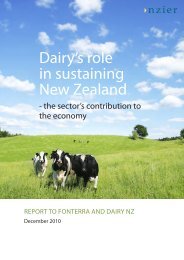You also want an ePaper? Increase the reach of your titles
YUMPU automatically turns print PDFs into web optimized ePapers that Google loves.
•<br />
Proactively<br />
Good<br />
Brian and Jacqui Wellington<br />
...Continued<br />
the deer waste is still used. Feed pit scrapings are regularly set<br />
aside, lime is mixed in and the brew sits until March when it is<br />
applied back onto pasture. “That’s fertiliser we don’t have to<br />
buy,” says Brian.<br />
JUDGES’ COMMENTS<br />
looking for new innovations, finding solutions, trying new ideas.<br />
•<br />
mix of stock variety for land and soil types and to fit feed quality and demand.<br />
•<br />
Good work/leisure balance.<br />
Excellent fencing of waterways and planting of natives.<br />
Behavioural observation is put to good use throughout the<br />
farm minimising the unproductive and destructive problem of<br />
fence pacing by the deer. A number of measures are standard<br />
practise explains Brian: “We always try to keep them fully fed,<br />
we move them on if the weather is wet, so they aren’t eating<br />
dirty pasture, we have electric outriggers on all fences, and we<br />
always try to work it so we never have deer on both sides of<br />
the fence.” This last measure is the most difficult to implement<br />
he says. “Trying to put it in practise is the hardest part, it does<br />
take a lot of planning, but it is worth it.”<br />
Understanding the territorial nature of stags, particularly during<br />
the four-month period around the roar, dictates how they are<br />
managed. Once they get to around 3.5 years old, stags are set<br />
stocked during the roar at five to a hectare on the rougher<br />
ground. “Then you leave them alone and they find their own<br />
spots and they are happy. You can’t move them once they start<br />
to roar.”<br />
Brian is positive about the bloodlines they are fostering. “We’ve<br />
spent a lot of money on breeding stags at times and it is now<br />
showing up, especially in our velveting stags.” The improvement<br />
is clear when it is considered a two-year-old stag in the 1980s<br />
producing 1.1kgs of velvet was a keeper, now that figure is 2.2kgs<br />
and up. “This year we had a stag cut 10kgs and it’s only six, we<br />
are thrilled.”<br />
Apart from Brian and Jacqui there are two full-time employees<br />
on the farm, a stock manager and a general hand.
















